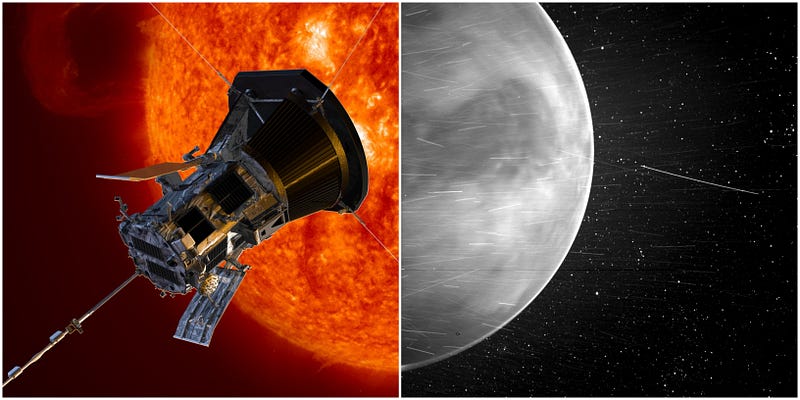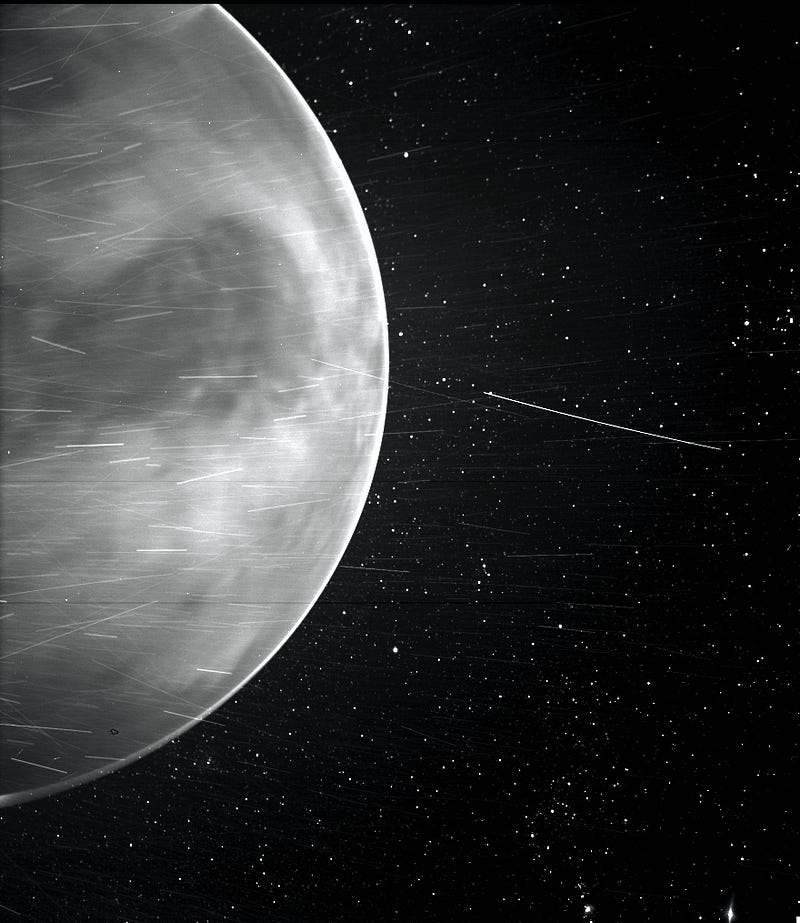Exciting Discoveries: New Insights from Venus by Parker Solar Probe
Written on
Chapter 1: Unveiling Venus
Recent images captured by the Parker Solar Probe have provided intriguing insights into Venus, showcasing unexpected scientific revelations.

Originally engineered to investigate the Sun, the Parker Solar Probe has also demonstrated a remarkable ability to peer through the dense clouds of Venus. As part of its mission, the probe orbits the Sun in a way that allows it to approach Venus seven times over the course of its seven-year journey. Utilizing the gravitational forces of the planets, it alters its trajectory within the Solar System.
On July 11, 2020, during its third encounter with the Sun, the probe recorded a stunning image of Venus from approximately 12,380 kilometers (7,693 miles) away from the planet's night side.
Section 1.1: The WISPR Camera
The Wide-field Imager for Parker Solar Probe (WISPR) is designed for capturing images of the Sun's inner heliosphere and solar wind in visible light.

Using WISPR, the Parker Solar Probe identified unexpected characteristics both on and above Venus's surface. This camera employs two radiation-hardened Active Pixel Sensor CMOS detectors, which are preferred over traditional CCDs due to their lightweight design, lower power consumption, and increased resistance to radiation damage from cosmic rays and high-energy particles. The camera's lenses are made from a durable BK7 glass, commonly utilized in space telescopes, ensuring resilience against dust impacts.
One of the latest images of Venus reveals a luminous ring along the planet's edge, potentially indicating nightglow—light produced when oxygen atoms, separated by sunlight, recombine into molecules.
“Sometimes… my thoughts drifted… one time, they even went to Venus and ordered a meal I couldn't afford.” ? Steven Wright
The dark area in the center of the image is known as Aphrodite Terra, the largest elevated region on Venus, appearing dark due to its temperature being around 30 degrees Celsius (54°F) lower than the surrounding areas.
WISPR is specifically designed and tested for visible light observations. Researchers anticipated seeing clouds but were surprised to find that the camera could penetrate directly to the surface, as noted by Angelos Vourlidas, WISPR project scientist from the Johns Hopkins Applied Physics Laboratory (APL).
This unexpected clarity raises intriguing questions for both mission engineers and astronomers—what enabled WISPR to see through Venus's dense clouds? The leading hypotheses suggest that either WISPR possesses enhanced sensitivity to infrared wavelengths than anticipated, or a thinner section of clouds allowed clearer visibility.
Both scenarios could lead to exciting new scientific discoveries. If WISPR can accurately capture infrared light, it could serve as a valuable tool for studying dust and pebbles, similar to those that contributed to the formation of rocky planets within our inner solar system. Conversely, discovering an unanticipated gap in the clouds would enhance our understanding of the atmospheric dynamics of Venus.
The first video, NASA Space Probe Unexpectedly Glimpses The Surface of Venus in Stunning New First, elaborates on the fascinating findings and implications of these new images.
Chapter 2: Collaborative Research with Akatsuki
The WISPR team is collaborating with the researchers overseeing Japan’s Venus-orbiting Akatsuki mission. This spacecraft captures infrared images of Venus, producing visuals akin to those unexpectedly recorded by Parker.
“If WISPR can detect thermal emissions from the surface of Venus and nightglow—most likely from oxygen—along the planet's limb, it can significantly contribute to our studies of Venus's surface,” states Javier Peralta, a planetary scientist from the Akatsuki team.
On February 20, 2021, WISPR captured another set of images of Venus's night side, with analysis expected to be completed by April this year.
James Maynard, the founder and publisher of The Cosmic Companion, is a New England native who now resides in Tucson with his wife, Nicole, and their cat, Max.
Did you enjoy this article? Connect with us on The Cosmic Companion Network for our podcast, weekly video series, informative newsletter, and more!
The second video, Parker Solar Probe New Views of Venus Surface From Space - YouTube, provides further insights into the intriguing discoveries made by the Parker Solar Probe.